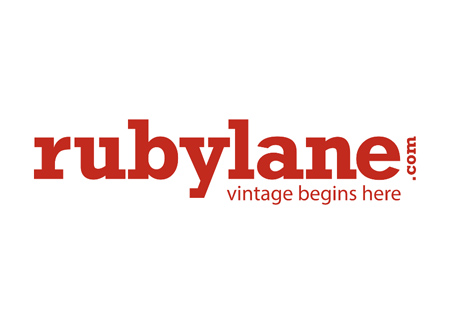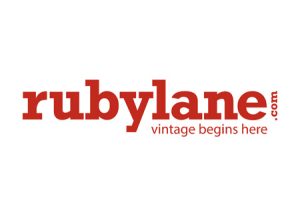
The COVID-19 pandemic has disrupted retail along with all facets of everyday life. Online shopping is no exception, but how are diehard collectors coping? And how is it impacting online sellers and antiques dealers?
We checked in with Palmer Pekarek to find out what changes he’s seeing at antiques & collectibles marketplace Ruby Lane.
Sales are steady on Ruby Lane as shoppers are seeking items that provide comfort – specifically, nostalgic items such as dolls and anything doll related. Other items that bring back memories of yesteryear are doing well, including fun games from the 50s, 60s, 70s; vintage barware, and jewelry. (It sounds like some people are living it up as they work from home!)
Pekarek said items that have price points under $750 are selling more right now, and some of the larger and more expensive items are taking a little more time to sell as people are being cautious about big-ticket spending – which he referred to as $7,500-plus.
As for Ruby Lane dealers, Pekarek said shop owners are bringing more inventory online. In addition to shop owners devoting more time to their online shops, Ruby Lane is seeing new sellers on the site.
“We have seen new and exciting listings come to the site. We believe shop owners are taking Spring Cleaning to a new level and seem to be discovering hidden treasures tucked away in storage closets at home.”
Possibly helping Ruby Lane attract more inventory is the fact it doesn’t charge listing fees. It also recently announced a reduction in maintenance fees for April and May to relieve some of the stress shop owners might be experiencing. “While this is an important revenue stream for Ruby Lane, we anticipate we will have options for special short-term small business loans to keep operations going due to this loss in revenue,” the company had told sellers in its announcement.
FedEx, USPS and UPS are still working around the clock to pick-up and deliver items to buyers, Pekarek said, but shipping large items such as furniture is taking a little longer than usual due to “Shelter in Place” restrictions.
Sellers are taking safety measures when packing and shipping items, he said, and home pickup of items has been very helpful in keeping shop owners at home and healthy.
Asked how the COVID-19 outbreak impacted Ruby Lane itself, Pekarek said the team has worked from their respective home offices for over 20 years, and they continue to work every day of the week.
“Our entire team is working to keep sellers selling and buyers buying – this has been a time of creative solutions.” In addition to the discounted monthly maintenance fees for sellers, he said Ruby Lane brought discounted shipping programs back to the forefront for sellers.
We asked what advice Ruby Lane could offer sellers dealing with the current challenges. “Keep listing items and work your shop from the safety of your home. For many of our sellers, this is a full time occupation, staying safe and healthy is the most important path to follow. Be patient, we believe that sales will return to higher levels in the not so distant future.”
When looking ahead to September 2020, what does Ruby Lane expect to see when it comes to online shopping, and online selling?
“We believe more sellers will be online selling than ever before,” Pekarek said. “Some brick and mortar shops will move their operations out of traditional spaces to online marketplaces. Many buyers and sellers have realized that ordering online (from groceries and collectibles to paint and clothing) is easy, safe, and alleviates the need to fight traffic and crowds. It also saves unnecessary overhead costs.
“Our greatest hope, however, is that life returns to a place that welcomes socialization and promotes good health.”





I am sure more people are shopping online than ever, to avoid person-to-person contact and I pray every day for those who have lost loved ones so unnecessarily. My sincerest wish is a return to normalcy to get our nation going again and the economy improving. This has been an absolutely unthinkable experience for the nation. It is beyond infuriating to see some of the “leaders” in government and the media politicizing it.
Unfortunately this outbreak comes on the heels of Ruby Lane imposing a 6% charge on an items selling price, to help pay for staff and other things they needed after they had to start charging sales tax. I wonder if Mr. Pekarek’s observation that store owners are adding inventory is happening not because they are looking forward to expanding, but rather because they are trying to unload inventory and possibly close their shops looking for a cheaper place to sell. There is no way to increase the prices on existing listings to absorb such a costly increase on the shop – customers will notice and rebel.
At least RubyLane discontinued the BUYER fee they imposed on customers who (they said) would accept paying the additional charge, because it was like an auction buyer premium. That fee drove customers away, as has been reported in eCommercebytes posts.
It may be true that more people are shopping online but they are not coming to my Ruby Lane shop.. And I have friends that have been on Ruby Lane for quite a few years and they are not selling either. And our pricing is not even close to the $750 that Mr.Pekarek quotes. There was no uptick in sales that we are aware of – and I sell quality products with a perfect record. There are NO sales. Fees are very high on Ruby Lane unless you sell high dollars BUT now Ruby Lane has implemented a 6.7% sellers fee on each item the seller has to pay. They mention the $30 credit for maintenance – first of all it is my understanding they are going to file to get that back from the covid-19 stimulus. And it is I believe for 2 months. If they get it back from the govt – which I believe is wrong – what have they given us? Prior to the sellers fee they blindsided buyers and sellers with a 3% buyers fee – like an auction house would charge. It did not take long – the push back made them take that back. And put it on the backs of the sellers – which is what part of the 6.7% sellers fee is. And as the previous writer notes we simply cannot raise the prices to cover that cost. In my case it costs me 60 cents per item per month to relist which is over $100.00 a month. It is April 14th and I have sold nothing on Ruby Lane in April and 2 items in March but I have sold on another venue. As far as stocking up to sell I am not hearing that. I am hearing sellers trying to move their items so they can leave Ruby Lane. At this point in time it is more expensive to sell on Ruby Lane than Ebay. There is very little to no advertising for sellers.
I am sorry to say that I do not see things the way Mr.Pekarek does. And I know a number of sellers who do not see through the rose colored glasses that Mr Pekarek does.
Whatever the case, that’s one thing I always liked about Ruby Plaza (owned by Ruby Lane)…they always keep their customers informed, particularly about important topics. That and the fact that only ONE site change affected shops in all the time I sold there and they just shut down the site to fix it rather than have sellers dealing with issues.
Not the kind of moral behavior you see from those sites that so frequently claim to help small business. Then again, what do you expect when they’re financed by WallStreet greed? Hence, the reason no such business offering such a service to small businesses in eCommerce should ever be governed by investors.
If they can’t put their money in and keep their mouths shut, then they need to just keep their money. If they want to have more of a say in the matter, then go through the legal system to ensure that what is decided does right by the people they’re serving. Don’t want that hassle? Then don’t invest.
@Picky Chicky – Ruby Plaza has been CLOSED for going on EIGHT YEARS! (See EcommerceBytes-NewsFlash, Number 2794 – May 01, 2012 ) so while I definitely agree with you about how it was handled, you need to speak about it in past tense. Many eCommercebytes subscribers may not realize it’s a thing (sadly) of the past. I had a store on Ruby Plaza, and felt it was really great competition for Etsy. “IF ONLY” Ruby Lane had not decided to dump it. I think it fell victim to the poor management/business decisions that seem to have plagued Ruby Lane since the beginning. They don’t seem to be able to think from a store owner standpoint.
Sadly, Ruby Lane seems to have been plagued by the things Crackerjacks mentioned, all of which I totally agree with, because I have been having the same experiences.
One that bothers me is the 6% charge per item selling price. Supposedly this is to offset new costs created by the new sales tax structure including new staff. Ruby Lane is now an Avalara client and surely there is a big bill for that. Avalara does the sales tax software for I don’t know how many big businesses, world wide.
However, if they were concerned about funding new staff salaries and Avalara charges, I would think Ruby Lane should have implemented a PREDICTABLE flat fee per shop that would guarantee a known amount. Charging 6.7% on final sale price is wildly unpredictable, and would seem not the best way to fund known, predictable expenses?
Yes – Ruby Lane for me is now more expensive than eBay. Yes, I am looking at my own website instead. The ONLY way I can try to justify the increased costs is that some of the bookkeeping programs do secretarial type work that saves me real time not having to do it myself, but I cannot continue when my store costs me more than 20% per item to sell!!! and items are sitting with no sales coming in.